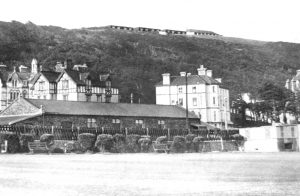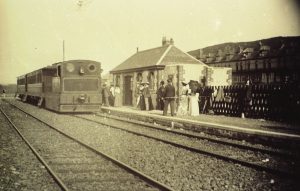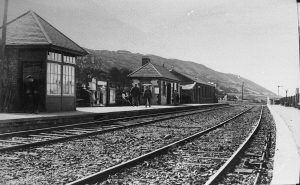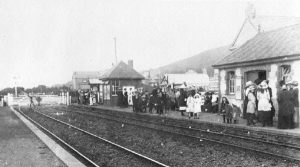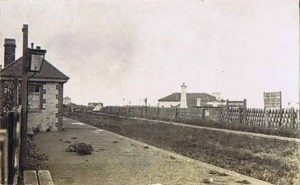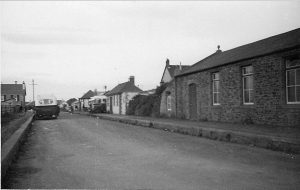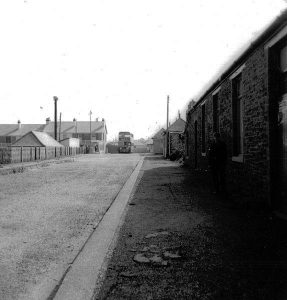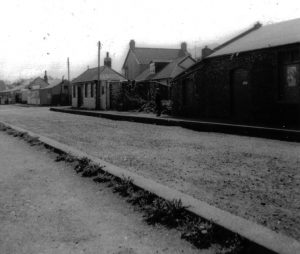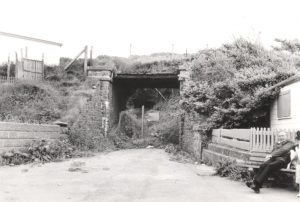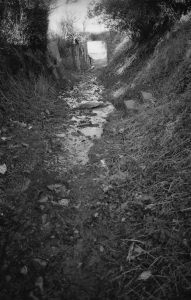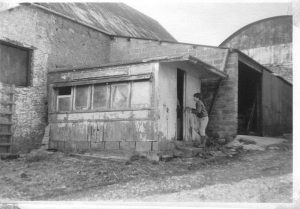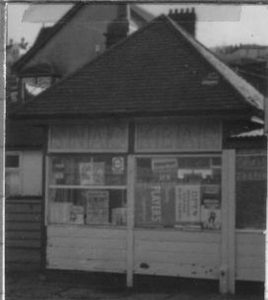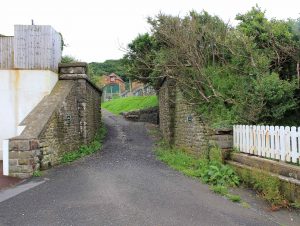Bideford, Westward Ho! and Appledore Railway
The Bideford, Westward Ho! and Appledore Railway was most unusual amongst British railways in that although it was built as a standard gauge 4 ft 8 1⁄2 in line, it was not joined to the rest of the railway network, despite the London and South Western Railway having a station at Bideford, East-the-Water, just on the other side of the river Torridge from the main town.
The line was wholly situated on the peninsula made up of Westward Ho!, Northam and Appledore with extensive sand dunes by the Torridge and Taw estuary. The line opened in stages between 1901 and 1908, but closed in 1917, having been requisitioned by the War Office. Re-opening the line after World War I was considered, but dismissed as a viable option.
Construction and opening
A scheme for building this railway was suggested as early as 1860 with a bridge across the Torridge and stations at Northam, Appledore, Clovelly, Hartland and Bude. In 1866 a start was actually made on a line to run to Appledore with a branch to Westward Ho!, however soon after a full ‘first sod cutting ceremony’ by the Earl of Iddesleigh, the contractors went bankrupt and the project was abandoned. A project to create a 10 1⁄2 miles (16.9 km) branch from Abbotsham Road Station to Clovelly had been put forward by Messrs. Molesworth and Taylor.
The route and construction sections
Finally the Bideford, Westward Ho! & Appledore Railway was incorporated on 21 May 1896, with its Head Office address at the Electrical Federation Offices in Kingsway, London WC2. Soon after the line passed to the British Electric Traction Company (BET). It was not until 24 April 1901 that the single track line was opened as far as Northam, although the first trial train ran with a few friends of the directors in January 1901. The first train, pulled by Grenville was played off by Herr Groop’s German Band which had been hired for the season and it reached speeds of 36 mph on its inaugural run. The remaining extension to Appledore finally opened in 1908, on 1 May, costing £10,000. The railway was built in three sections, with the first being from Bideford at 0.39 km, the second from the termination of the first, being to Westward Ho!, length 6.4 km, 7.23 km, and the third being from the termination of the second, to Appledore, length 3.2 km, 3.91 km.
The contract for construction was awarded to a Mr Charles Shadwell of Blackburn and the estimate was for £50,000. The initial outlay was £87,208 and Mr Shadwell was removed from his post on 13 December 1901. A subsequent court action proved that he did ‘wilfully default’ and judgement was given against him in 1905 for £7,500. Plans had been made for a 3 ft gauge track, however as it was hoped to connect the line with the L&SWR by a bridge over the Torridge, the line was built to a Standard Gauge specification. Gradients were severe in places, with a 1 in 47 on the Kenwith Castle to Abbotsham Road section.
The rails were delivered by boat to Bideford Quay by the S.S. Snipe in May 1898 and the sleepers also arrived at the quay, coming from West Hartlepool in September. Wood blocks were used on the quay, flush with the road surface to deaden the noise, as was the practice on roads with heavy horse and cart traffic in many places. The wood became very slippery and caused accidents in wet weather, the company not always being as careful with the application of sand and gravel as it should have been.
The Company filled in and culverted the stream coming down from Kenwith Castle, creating reclaimed land and preventing the high tides flowing up to the castle. The council had designs on this ‘new land’ and complained that the railway did not skirt the edge to release the land for other purposes.
Stations, halts and track layout
Trains started from Bideford Quay on their scenic journey across the peninsula to the cliffs at Cornborough and Westward Ho!, then over the fields close to Northam Burrows, finally coming to the terminus at the port of Appledore, with its shipyards and maritime traditions.
The line was seven miles (11 km) in length when fully opened in 1908. There were eleven stations and halts which largely served visitors wishing to enjoy the bracing air along the coastline, or to swim in the clear waters.
After Bideford (Quay) was a halt at Bideford (Strand Road) Halt, which was close to the ‘Yard’ with the principal engine, carriage, and maintenance sheds. Chanter’s Lane Halt or ‘The Lane’ Halt was next, followed by The Causeway Halt, which had a two storey traditional signal box built by order of the Board of Trade who had inspected the line a month after it opened. Following on from these were Kenwith Castle Halt, Abbotsham Road Station, Cornborough Cliffs Halt with its wooden platform, Westward Ho! Station, Beach Road Halt, Northam Station (Pimpley Road) with a platform and waiting room, Richmond Road Halt with a level crossing, platform and shelter, Lovers Lane Halt with a platform and finally Appledore Station, which lay close to the Anglican church.
Westward Ho! Station
Westward Ho!, the busiest station, had its own Station Master, Mr. MacLaughlan; it had two platforms, platform lighting, a passing loop, ticket office, an 8-lever signal box and a 2-lever ground frame operated by Mr. Spry; a waiting room, refreshment room, bookstall, level crossing gates and a Concert Hall called the Station Hall. A siding ran to the Westward Ho! Gas Works. An early photograph shows Westward Ho! with only the signal box and a long unbroken fence running along the back of the platforms with no other buildings or lighting. The similarity in appearance and construction between the Westward Ho! and Appledore platform buildings suggests that they were both built at the same time, circa 1908.
In an effort to entice the public onto their trains and provide shelter during inclement weather, the company built a Concert or Reception Hall on the ‘up’ platform at Westward Ho! in 1901 / 02, it was called the Station Hall. Performers such as the ‘Jolly Dutch’ and Clog Dancers performed in Station Hall. It was an expensive undertaking, costing £17 9s 7d in 1906, under the heading of ‘Services of Minstrels’ in the traffic expenses log. The building was well built and still stood in 1980 as a ‘Beer Garden’.
Different views of the Westward Ho! station:
Decline, closure and disposal
The line was never on a firm financial footing and the situation worsened with the rising cost of coal and the effects of the First World War; additionally competition from Dymond’s Horse Drawn Coach and later Motor Buses took much of the traffic off the line even in summer. Few passengers from Bideford Station at East-The-Water would trouble to change again for the B,WH&A,R at the Quay when alternative transport would take them straight to their destination for less money. Trains did not run at times suitable for manual workers and freight, apart from Westward Ho! Gasworks, had always been a minor consideration. The line could not even manage the ½% dividend of the Lynton & Barnstaple Railway and eventual closure was inevitable.
In 1917, the Minister of Munitions requisitioned the line by Government Order for War Service and it duly closed on 28 March of that year. Grenville and Torridge were loaded onto the captured German freighter Gotterdammerung for duty in France, but the ship was torpedoed off the north Cornwall Coast and sank. The wreck was discovered in 2001 and the locomotives may be recovered for restoration as static displays.
Kingsley was scrapped in 1937 after having been sold by the Ministry of Munitions to the National Smelting Company. The locomotives, derailing several times, had to be run across the medieval Bideford Bridge on temporarily laid track, then running along Barnstaple Street joining up with the old L.& S.W.R.line at Bideford’s Goods Yard. The operation took two days to complete. Their iron side protectors or ‘skirts’ were removed to reduce the weight of the locomotives.
On 29 April 1921 Blackmore’s held an auction at the Works Yard in Bideford and sold the six carriages and also possibly the trackbed in separate lots. One carriage was cut in half and used on the beach at Westward Ho! near Nassau Baths as Beach Huts, whilst the others were taken to the Midlands for scrap. Some of the line’s equipment was purchased for further use by Colonel H. F. Stephens, through his company Associated Railways. The fate of the signal boxes is unclear (see Bits and Pieces), however the Westward Ho! box was still being used as sweet shop on its original site as late as 1970.
A section of a carriage which had been used as beach hut at Westward Ho!, close to the Nassau Baths being inspected by Roger Griffith from Grenville College in the 1960s.
The station area after the railway had gone:
Further information can be seen on Wikipedia, from where much of the above came.
The map below shows the path of the old railway. Identified are the “Halts” and Stations

